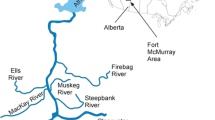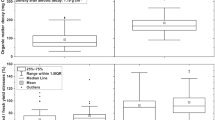Abstract
Purpose
This research aims to investigate: (1) the evolutional sequence of erosion of cohesive sediments entering the Athabasca River, (2) the influence of consolidation/biostabilization time on bed sediment stability, and (3) the implication of these results on contaminant transport within the Athabasca River.
Materials and methods
A 5-m annular flume was used to generate bed shear to assess cohesive sediment dynamics for eroded beds with consolidation/biostabilization periods (CBs) of 1, 3, and 7 days. Additional laser particle sizing, image analysis, densitometry, and microbial analysis were employed to further the analysis with respect to bed erosion and eroded floc characteristics.
Results and discussion
The critical bed shear stress for erosion increased from 0.16 (1-day CB) to 0.26 Pa (7-day CB) with an inverse relationship observed for both suspended sediment concentration and erosion rate with respect to CBs. The 7-day CB yielded the largest eroded flocs that initially have high organic content but were quickly broken up with increasing shear. The strongest eroded floc population occurred for the 3-day CB. Eroded flocs were found to be of an open matrix with high water content and low density. Flocs contained a mixture of clay and silt particles, microbes, algae, diatoms, and secreted extracellular polymeric substances (EPS). Counts of bacteria were observed to decrease with CBs while an increase in the algal community is suggested with time.
Conclusions
Consolidation was believed to have limited effect on erosion while biostabilization was the main controlling factor. Increasing biostabilization with time resulted in a more stable surficial layer with a reduced erosion rate relative to less biostabilized beds. The highly biostabilized bed (7-day CB), however, yielded the largest flocs which broke up easily compared to those eroded from 1- and 3-day CBs. It is believed that the EPS produced by the sediment biological community is the main component of the bed and flocs that is responsible for the observed stability results.







Similar content being viewed by others
References
Amos CL, Droppo IG, Gomez EA, Murphy TP (2003) The stability of a remediated bed in Hamilton harbour, Lake Ontario, Canada. Sedimentol 50:149–168
Amos CL, Bergamasco A, Umgiesser G, Cappucci S, Cloutier D, DeNat L, Flindt M, Bonardi M, Cristante S (2004) The stability of tidal flats in Venice Lagoon—the results of in-situ measurements using two benthic, annular flumes. J Mar Sci 51:211–241
Amos CL, Umgiesser G, Ferrarin C, Thompson CEL, Whitehouse RJS, Sutherland TF, Bergamasco A (2010) The erosion rates of cohesive sediments Venice lagoon, Italy. Cont Shelf Res 30:859–870
Berkhout N (1994) Manual “UHCM”, Ultra High Concentration Meter. Delft Hydraulics, Rotterdam
Droppo IG (2004) Structural controls on floc strength and transport. Can J Civ Eng 31:569–578
Droppo IG (2009) Biofilm structure and bed stability of five contrasting freshwater sediments. Mar Fresh Wat Res 60:690–699
Droppo IG, Stone M (1994) In-channel surficial fine-grained sediment laminae (Part I): physical characteristics and formational processes. Hydrol Proc 8:101–111
Droppo IG, Amos CL (2001) The structure, stability and transformation of contaminated lacustrine surface fine-grain laminae. J Sed Res 71(5):718–727
Droppo IG, Leppard GG, Flannigan DT, Liss SN (1997) The freshwater floc: a functional relationship of water and organic and inorganic floc constituents affecting suspended sediment properties. Wat Air Soil Pollut 99:43–53
Droppo IG, Lau YL, Mitchell C (2001) The effect of depositional history on contaminated bed sediment stability. Sci Tot Environ 266:7–13
Droppo IG, Ross N, Skafel M, Liss SN (2007) Biostabilization of cohesive sediment beds in a freshwater wave-dominated environment. Limnol Oceanogr 53(2):577–589
Eaton AD, Clesceri LS, Rice EW, Greenberg AE (2005) Standard methods for the examination of water and wastewater, 21st edn. American Public Health Association, American Water Works Association, Water Environment Federation, Baltimore
Environment Canada (1994) Manual of analytical methods, v. 1. Major ions and nutrients. Environmental Conservation Service (ECD). Canadian Communications Group, Toronto
Francois RJ (1987) Strength of aluminum hydroxide flocs. Wat Res 21:1023–1030
Gerbersdorf SU, Jancke T, Westrich B (2007) Sediment properties for assessing the erosion risk of contaminated riverine sites. J Soils Sediments 7(1):25–35
Gerbersdorf SU, Jancke T, Westrich B, Paterson DM (2008) Microbial stabilization of riverine sediments by extracellular polymeric substances. Geobiology 6:57–69
Gerbersdorf SU, Bittner R, Lubarsky H, Manz W, Paterson DM (2009) Microbial assemblages as ecosystem engineers. J Soils Sediments 9:640–652
Ghosh U, Gillette JS, Luthy RG, Zare RN (2000) Microscale location, characterization, and association of polycyclic aromatic hydrocarbons on harbour sediment particles. Env Sci Tech 34:1729–1736
Hawley N (1982) Settling velocity distribution of natural aggregates. J Geophys Res 87(C12):9489–9498
Headley JV, Akre C, Conly FM, Peru KM, Dickson LC (2001) Preliminary characterization and source assessment of PAHs in tributary sediments of the Athabasca river, Canada. Environ Forensis 2:335–345
Jarvis P, Jefferson B, Gregory J, Parsons SA (2005) A review of floc strength and breakage. Wat Res 39:3121–3137
Krishnappan BG (1993) Rotating circular flume. J Hydraul Eng 119(6):758–767
Krishnappan BG (2000) Modelling cohesive sediment transport in rivers. In: Stone M (ed), The role of erosion and sediment transport in nutrient and contaminant transfer. Proceedings of the International Association for Hydrological Sciences, Waterloo, Ontario, Canada, IAHS Pub 263, pp 269–276
Krishnappan BG (2007) Recent advances in basic and applied research in cohesive sediment transport in aquatic systems. Can J Civ Eng 34:731–743
Krumbein WE, Paterson DM, Stal LJ (eds) (1994) Biostabilization of sediments. Verlag, Oldenburg, p 526
Lambert CP, Walling DE (1988) Measurement of channel storage of suspended sediment in a gravel-bed river. Catena 15:65–80
Larkin PA (1978) Biometrics—a handbook of elementary statistical tests. University of British Columbia, Vancouver, British Columbia, Canada
Liao BQ, Allen DG, Leppard GG, Droppo IG, Liss SN (2002) Interparticle interactions affecting the stability of sludge flocs. J Colloid Interf Sci 249:372–380
Liss SN, Droppo IG, Flannigan D, Leppard GG (1996) Floc architecture in wastewater and natural riverine systems. Env Sci Tech 30(2):680–686
Lundkvist M, Grue M, Friend PL, Flindt MR (2007) The relative contributions of physical and microbiological factors to cohesive sediment stability. Contin Shelf Res 27(8):1143–1152
Maruya KA, Risebrough RB, Horne AJ (1996) Partitioning of polynuclear aromatic hydrocarbons between sediments from San Francisco Bay and their porewaters. Env Sci Tech 30:2942–2947
Milligan TG, Hill PS (1998) A laboratory assessment of the relative importance of turbulence, particle composition, and concentration in limiting maximal floc size and settling behavior. J Sea Res 39:227–241
Parker DS, Kaufman WJ, Jenkins D (1972) Floc breakup in turbulent flocculation processes. J Sanit Eng Div: Proc ASCE SA1:79–99
Paterson DM (1997) Biological mediation of sediment erodibility: ecology and physical dynamics. In: Burt N, Parker R, Watts J (eds) Cohesive sediments. John Wiley, New York, pp 215–229
Petersen O, Krishnappan BG (1994) Measurement and analysis of flow characteristics in a rotating circular flume. J Hydraul Res 32(4):483–494
Ravens TM, Gschwend PM (1999) Flume measurements of sediment erodibility in Boston harbor. J Hydraul Eng 125(10):998–1005
Salhani N, Uelker-Deffur A (1998) Improved quantification of aggregated bacteria by combined enzymatic and mechanical treatment of flocs and biofilms from a rotating drum bioreactor. Wat Res 32:1287–1295
Smith DJ, Underwood JC (1998) Exopolymer production by intertidal epipelic diatoms. Limnol Oceanogr 43(7):1578–1591
Stone M, Krishnappan BG, Emelko MB (2008) The effect of bed age and shear stress on the particle morphology of eroded cohesive river sediment in an annular flume. Wat Res 42:4179–4187
Sutherland TF, Amos CL, Grant J (1998) The effect of buoyant biofilms on the erodibility of sublittoral sediments of a temperate microtidal estuary. Limnol Oceanogr 43(2):225–235
Teisson C, Ockenden M, Le Hir P, Kranenburg C, Hamm L (1993) Cohesive sediment transport processes. Coastal Eng 21:129–162
Yallop ML, Paterson DM, Wellsbury P (2000) Interrelationships between rates of microbial production, exopolymer production, microbial biomass and sediment stability in biofilms of intertidal sediments. Microb Ecol 39:116–127
Acknowledgments
JG-A thanks the CONACYT Mexican funding agency for the economic support during a sabbatical at Environment Canada. We also thank the staff of Alberta Sustainable Resource Development at Fort McMurray for their support with the sampling equipment and shipping of samples.
Author information
Authors and Affiliations
Corresponding author
Additional information
Responsible editor: Sabine Ulrike Gerbersdorf
Rights and permissions
About this article
Cite this article
Garcia-Aragon, J., Droppo, I.G., Krishnappan, B.G. et al. Erosion characteristics and floc strength of Athabasca River cohesive sediments: towards managing sediment-related issues. J Soils Sediments 11, 679–689 (2011). https://doi.org/10.1007/s11368-011-0345-4
Received:
Accepted:
Published:
Issue Date:
DOI: https://doi.org/10.1007/s11368-011-0345-4




